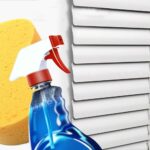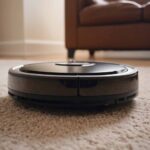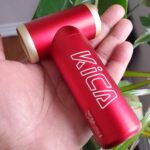Baseboard 90-degree outer corners are one of the most susceptible areas to damage in your home. Also known as mitered joints, these areas are often subject to more damage than their inside corner (coped joints) or flat counterparts.
High traffic areas, animals, and rambunctious kids can perpetuate the damage to your baseboards. Leaving baseboards corners with unsightly chips, scrapes, and dents.
For many years the issue of damaged baseboard corners really bothered me until I found some quick, easy solutions to solve the problem indefinitely.
Using a baseboard corner guard is one of the most effective ways of protecting baseboard miter joints from becoming damaged by foot traffic, animals, and kids in your home.
LATEST VIDEOS
How to protect your baseboards miter joint by using a corner guard
A corner guard is a 90 ° strip of material that sits over your miter joint. You can find them in plastic, rubber or metal.
If you decide to use plastic corner guards, you can easily apply a corner strip by peeling the adhesive backing off and sticking corner strip over the top of your baseboards miter joint.
Depending on the width of your baseboard, you will have to cut the plastic corner guard to fit evenly with the specific size of your baseboard.
If you’re looking for more stylish options, then opting for the metal corner guards might be a bit more ideal.
Like the plastic corner protectors, some metal types come with the same peel and stick adhesive backing.
Other types will require you to screw them in to stay intact.
Regardless of which type you choose, you’ll have many years of protection from animals, kids, and high traffic areas where baseboards can become chipped and broken.
Surprisingly Items like robot vacuums can nick your baseboards. In a recent article I talk about how to protect your baseboards from you robot vacuums.
The best paint to use to protect the baseboard corners
One of the best types of paints to protect baseboards is Acrylic-Alkyd hybrid. This new type of paint is known to dry faster and smoother, with fewer environmental concerns.
This primarily addresses baseboard corner care and repair. If you’re looking for a more in-depth guide on how to take care of baseboards in your home, you can check out my complete baseboard care guide here
Repairing damaged baseboard miter joints
If you have a few small chips in your baseboard miter joints, you can use a bit of spackle or a wood filler to fill the gashes. Additionally, both can be sanded to help you achieve your desired look.
Some people have recommended caulking to me. The main issue when using caulking is that it shrinks when it drys.
The shrinking causes it to crack and sometimes sink into the gash. It might even take a few applications to build up the surface of the caulking so that it sits flush with your baseboard.
Also, working with caulking can be difficult and takes a bit of finesse to give it a smooth and even look.
Using more durable material for your baseboards
If you’re installing a new baseboard, there are more durable options in the market.
Your standard baseboard is made out of a material called MDF. MDF is made out of wood fibers, which are heated and compressed together with resin binders.
MDF baseboards are typically easy to find at your big box hardware store like Home Depot. They usually come pre-primed for easy painting in a wide variety of styles.
It is a light, inexpensive material most builders use across North America. It can be somewhat sturdy in its compressed state.
It’s decent at absorbing direct impact, but it doesn’t hold up so well when an object chips it.
Water is one of the biggest enemies of MDF baseboards!
Here’s a list of a few alternative baseboard materials that can be used. Keep
With the advancement of technology, you can find baseboards in a wide range of materials and find the style of baseboard you’re looking for.
Below is a list of materials baseboards are made out of.
Keep in mind this list of materials can be more in price than your typical MDF baseboard. But these alternative materials will outlast the highest grade MDF baseboards in the market.
Add a multicooker to your arsenal
It can be challenging not to have the proper equipment for the job.
At the same time, I don’t want to fill my cupboards with 30 different pieces of equipment to achieve different things.
That’s why I invested in a multicooker, which is pretty darn close to cooking 30 different ways.
I’ve created a complete guide here on how multicookers can cook a variety of things all in one pot and will fit your budget too.
PVC – is a rigid type of plastic mostly used in the construction of pipes and applications such as doors and windows.
The popularity has grown now you can find them being used for interior door molding and baseboards.
One major of PVC if its durability and its resistance to water and mold. I’ve started using PVC in all my kitchens and bathrooms.
A few of my tenants allow water to run down the wall in the bathroom. This excessive water would cause the baseboards to swell from the moisture. Each time a tenant moved out, I would have to replace the old MDF baseboards in the washrooms.
Using PVC baseboards solved the need to replace the baseboards each time!
Vinyl – is similar to PVC in terms of its plastic look and feel. It’s not as rigid as PVC and not as popular in residential homes.
Vinyl is mostly used in commercial properties. I’ve seen it in some residential properties but mainly in the basement.
Wood – is one of the best choices to go with. Because it’s a natural material, so there is less worry about toxic elements.
Wood can also be repaired relatively easily using wood filler. You can do so much more with wood than it’s non-wood counterparts. It can be painted, sanded, stripped, and stained.
Wood molding was widely used in the construction of homes before 1980. Now its use has been limited and replaced by more economical materials like MDF. You can still find wood baseboards and trim in higher-end homes.
Tile – typically, you’ll see baseboards crated with tile in areas with tiled floors(bathroom, kitchens, and laundry rooms). Tiled baseboards are very durable, and they have a unique look.
One major drawback is if it becomes chipped, it won’t be as easy to repair as traditional baseboards.
Tiled baseboards are applied using a sticky adhesive instead of nails like some traditional baseboards.








